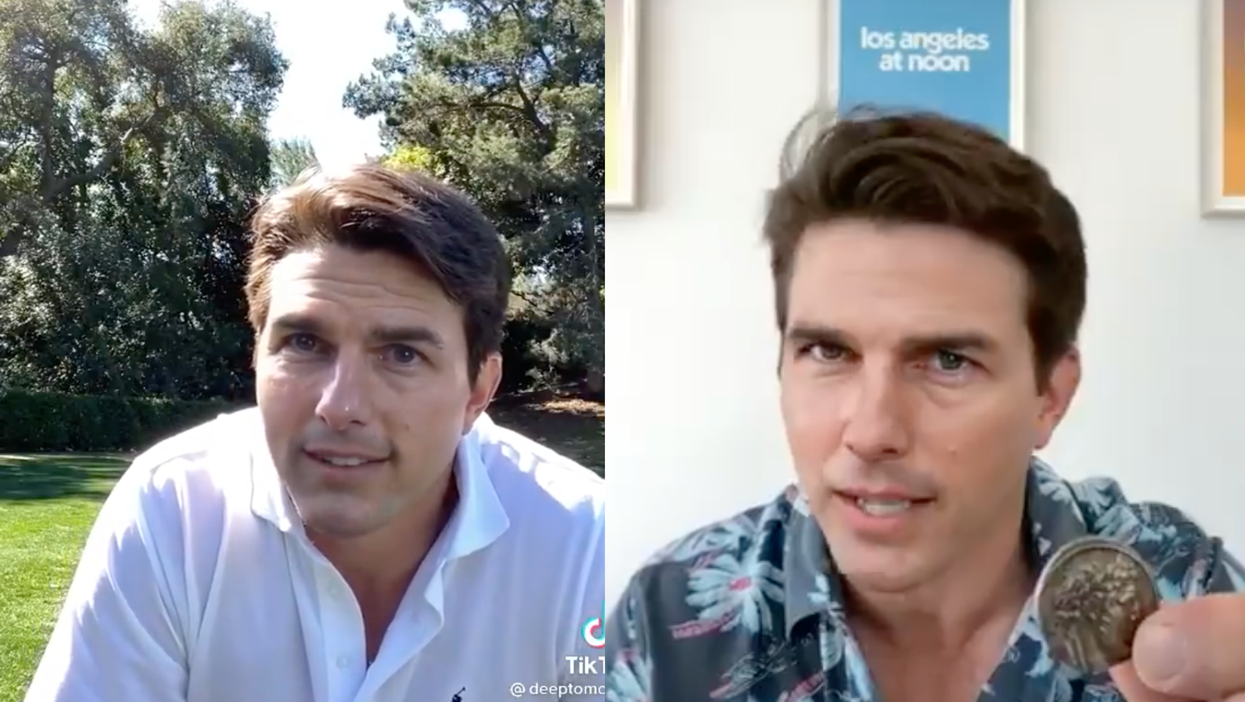
Two stills from last week’s viral Tom Cruise deepfakes
More deepfakes are flying across the internet at an alarming rate, after fake videos of Tom Cruise went viral on TikTok.
The videos have sparked questions around the genre of video sweeping across the internet after it was confirmed to NOT be the Mission: Impossible star who was seen telling jokes, playing golf and performing magic tricks. Aside from the face, it captured his signature maniacal laugh.
But where did deepfakes come from and what might impact might they have? Here, we answer some of the most pressing questions around the genre.
Where does the term deepfake come from?
According to Insider, the word deepfake stems from the AI technology called “deep learning”, which is an algorithm that is able to teach itself how to grapple with data sets and swap faces in images. Deepfakes were first used in 2017.
Hollywood has employed them for actors who are no longer with us or the age they were in the original movie, for example in the latest Star Wars spin-off movies Solo and Rogue One, which featured Carrie Fisher and Peter Cushing. These movies were set during the same time as the 1970s originals so CGI was required for continuity.
How are they made?
There are many different methods to create a deepfake but the most popular is a technology that enables face-swapping. In order to make one, you need footage to insert of the target.
Read more: 5 Tom Cruise deepfakes that are almost too real
How are they used?
Their usage ranges from the mundane to the sinister, from cinema to political campaigns. Amateurs can play around with lighthearted deepfakes on the FaceApp by switching genders, ages and other attributes.
Why are they bad?
Deepfakes can be used for any number of unethical means from revenge porn, for example. Findings from a Deeptrace report showed that porn made up 96 per cent of deepfakes in 2019. The Times reported that Emma Watson, Gal Gadot and Ariana Grande are common faces to use on porn sites, raising questions about consent.
Kayne West used the technology in his music video for the song Famous depicting a whole host of famous faces in the nude, including Kim Kardashian, Donald Trump and Taylor Swift.
They can spread misinformation to mass audiences very quickly. Instances of this have been hurtling across the Internet since their reveal, such as this video of what appears to be Mark Zuckerberg, founder and CEO of Facebook.
He is made to look like he delivered an interview to news outlet CBS concerning Facebook’s decisions about declaring advertisement revenue, which did not happen.
Another video features a creepy depiction of “Prince Charles”, appearing to apologise for his treatment his ex-wife Princess Diana, who died in a car crash in Paris in 1997. The real Prince Charles faced backlash after the early days of their relationship was portrayed on season four of Netflix’s The Crown forcing him to restrict their social media accounts.
One of the most worrying was a deepfake created by the Donald Trump campaign in the lead up to the 2020 US election. His team created a video of what looks like Joe Biden declaring his support for the President. This video was debunked but not before it was spread widely.
More humorously, these deepfakes of President Barack Obama and model Kendall Jenner simply show them bopping along to a catchy banjo beat.
However innocent they may seem, the technology still highlights the scary potential of video manipulation technology, especially in an age of disinformation. Aside from trust issues, deepfakes can also be used in creating pornographic images without the subject’s consent.
What are the experts and social media platforms saying?
TikTok and Instagram have not altered nor edited the viral Tom Cruise videos as they did not violate their terms and conditions. However, some people in tech, like Rachel Tobac, have called for labels so viewers know that what they are looking at is not real.
Sandra Wachter, a professor in the ethics of AI at Oxford University’ told The Times, “If you have something out there that is potentially very harmful for individuals or groups or could be a national security threat, then you obviously need to interfere. But I would also be worried about losing sight of the nuanced approach because the Tom Cruise video is arguably satire and you don’t want to take down that sort of content when it’s free speech.”
Facebook’s Mark Zuckerberg has testified in Congress about Facebook’s failure to moderate disinformation and according to the Guardian, Facebook is the biggest source for COVID-19 misinformation.
What’s their future?
We do not know about the future of deepfakes however we can confidently conclude that they are not going to go away any time soon.













